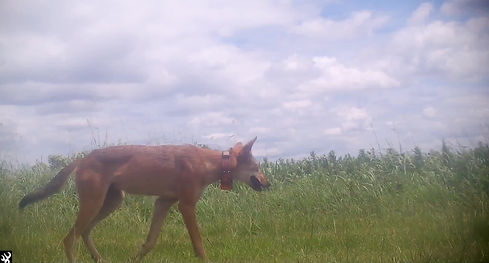Pack Structure
A pack is considered the base of wolf social organization and is typically defined as a cohesive family group that uses an established territory. It often contains a breeding pair and the current year's pups, as well as any of the previous year's surviving pups. For the purposes of annual population surveys, the Washington Department of Fish and Wildlife defines a wolf pack as "two or more wolves traveling together in the winter."

Size & Composition
Most family groups have between four and ten members, but that number can range from as few as two to as many as 15 wolves per family. The Druid Peak pack in Yellowstone National Park was exceptional and had 37 members at one point!
Packs can be anything from small nuclear families - made up of a breeding pair and their offspring - to large extended families with aunts, uncles, grandparents, and stepsiblings. These larger and more complex groups tend to be more common in landscapes that are saturated with wolves and supported by high prey densities. They also sometimes lead to multiple breeding pairs within a family group.
In a thriving population, wolf pairs can produce pups in the spring following a 63-day gestation period. Wolves then usually disperse from their family group when they are about 20 months old. Births, dispersals, deaths from disease, fights with neighboring families, and hunting by humans collectively shape the stability and structure of a wolf pack.
Pack Formation
In most wolf populations, a new family group forms when a female pairs with a male. However, in densely populated landscapes, opportunities to find a potential mate in an unoccupied area can be limited. New families also form through group dispersal or pack splitting.
Group dispersal occurs when two or more wolves permanently leave their former family group together and join unrelated wolves from another group to establish a new territory. In Yellowstone National Park, many new family groups formed when either same-sex siblings or same-sex parent-offspring pairs joined together with unrelated individuals that had dispersed from other family groups.
Pack splitting occurs when two or more wolves permanently separate from a family group and establish a new territory together, sometimes adjacent to the territory they just left. This can happen when families have multiple breeding pairs and competition for food, water, and other resources outweighs the benefits of staying together.


Social Dynamics
The prevailing view has long been that wolf families are socially structured under a strict dominance hierarchy, controlled by an “alpha” male and female pair, with other family members aligned in a pecking order. This view was primarily based on captive studies, where groups were largely composed of unrelated individuals interacting under the confines of captivity. It is now well known that captive conditions sometimes produce vastly different behaviors than what occurs in the wild.
“Alpha” status implies intense competition among family members to improve and/or obtain the highest rank. Leadership positions in most wild wolf families are determined by parents being dominant over their offspring. However, in places like Yellowstone National Park, relationships extend beyond parents and offspring, like half-siblings, aunts, uncles, nieces, nephews, grandparents, and grandkids.
The breeding pair typically direct the daily activities of the family group, but every member has a role. Wolves are among the relatively few species where other group members, in addition to the parents, contribute to offspring care known as alloparenting. Non-breeding adult helpers are usually related to pups.
Advantages with pack size
Alloparenting duties among wolves are varied and include provisioning pups with food; “pup sitting” at rendezvous sites while other adults are hunting; and teaching pups valuable family culture such as hunting techniques and how to navigate the landscape safely and efficiently. During times of resource scarcity, helpers may not only withhold provisioning, but also sometimes even steal food from pups.
In addition to having more helpers to provision pups, larger family groups have a numerical advantage during inter-pack competition for territory. Taking down large prey can sometimes be easier with more individuals, as can defending kills from scavengers. Studies have shown that ravens alone can remove up to 17 pounds of carcass per day and usurp 66% of a lone wolfs’ kill.

